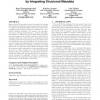446 search results - page 31 / 90 » Learning discrete categorial grammars from structures |
SIGIR
2000
ACM
13 years 12 months ago
2000
ACM
This paper explores the use of hierarchical structure for classifying a large, heterogeneous collection of web content. The hierarchical structure is initially used to train diffe...
KDD
2010
ACM
13 years 11 months ago
2010
ACM
Many social Web sites allow users to annotate the content with descriptive metadata, such as tags, and more recently to organize content hierarchically. These types of structured ...
CVPR
1998
IEEE
14 years 9 months ago
1998
IEEE
A new approach to the recognition of temporal behaviors and activities is presented. The fundamental idea, inspired by work in speech recognition, is to divide the inference probl...
CIBCB
2005
IEEE
14 years 1 months ago
2005
IEEE
— Part of the challenge of modeling protein sequences is their discrete nature. Many of the most powerful statistical and learning techniques are applicable to points in a Euclid...
COGSCI
2010
13 years 7 months ago
2010
many abstract categories (e.g., ``equivalence'') is innate. Although Plato argued with his contemporaries who advocated the empirical basis of knowledge, it was the Briti...


